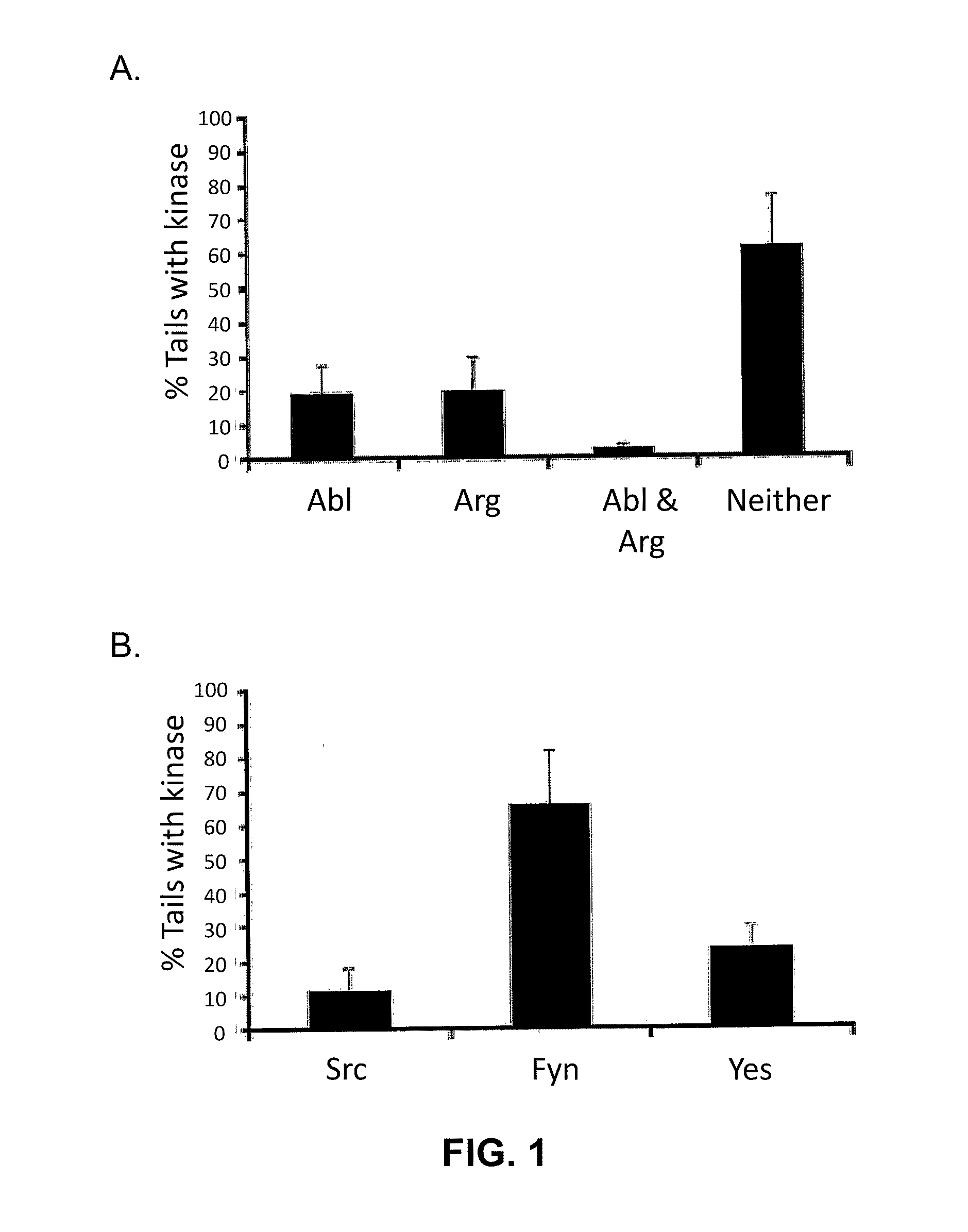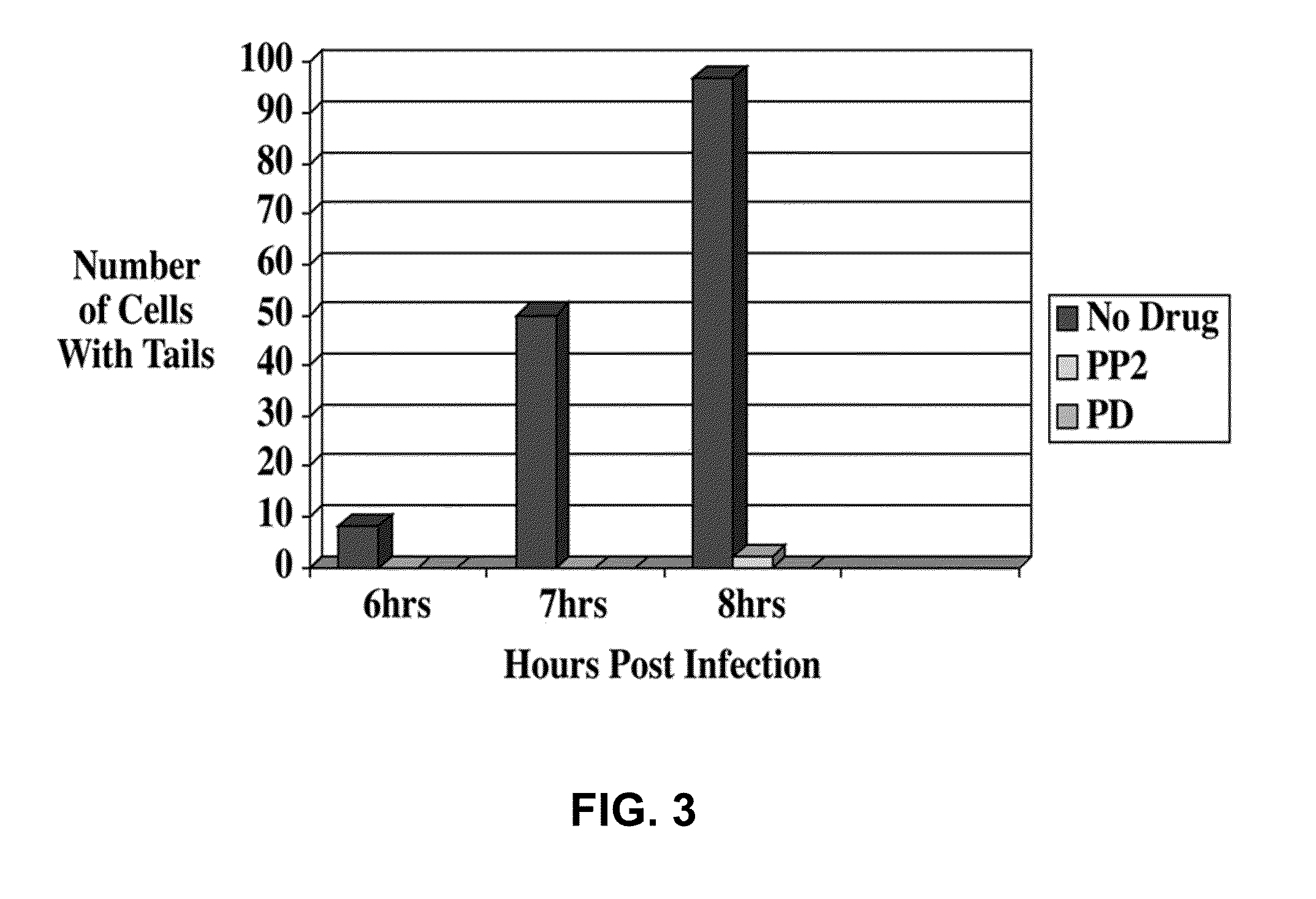Compositions and methods of use for tyrosine kinase inhibitors to treat pathogenic infection
a technology compositions, applied in the field of tyrosine kinase inhibitors, can solve the problems of inability to sustain success, most serious public health threat, and lack of effort on the part of pharmaceutical companies (big or small) to pursue developmen
- Summary
- Abstract
- Description
- Claims
- Application Information
AI Technical Summary
Benefits of technology
Problems solved by technology
Method used
Image
Examples
experiment 1
Src and Abl Family Tyrosine Kinases Participate in VV Actin Motility and Release of Infectious Virions
[0093]The purpose of the present experiment was to test whether several tyrosine kinases, including members of the Src family (c-Src, c-Fyn and c-Yes) and Abl family (c-Abl and c-Arg), are required for actin motility and release of infectious EEVs. Fibroblasts lacking one or more of these kinases in conjunction with potent inhibitors of these enzymes were used (Garcia-Echeverria et al. (2000) Med. Res. Rev., pp. 28-57).
Methods
[0094]3T3 cells, 3T3 cells derived from Abl− / − / Arg− / − mice, or 3T3 cells derived from Src− / − / Fyn− / − / Yes− / − mice were grown on glass coverslips in DMEM containing serum and incubated for sixteen hours at 37° C. with VV (strain WR) or VVGFP-B5R at a proper amount of m.o.i. For some experiments, cells were transfected one to two days prior to infection with plasmid vectors using Fugene-6 (Roche). Abl-T315I, Argl-T314I, and Src-T338M were constructed using Quik-Cha...
experiment 2
STI-X Inhibits Vaccinia Replication
[0129]This experiment involved screening a small library of compounds relating to STI-571 to identify a compound affecting VV replication. A derivative of STI-571, named STI-X, was identified and examined for its effect on VV infection, replication, and motility.
Methods
[0130]Methods for cell culture and fluorescence microscopy-based plaque assays were similar to those as described in Experiment 1.
[0131]In an effort to identify compounds that affect VV replication, a library of STI-571 derivatives was constructed by making modifications to particular moieties on the molecule. These compounds were screened based upon their ability to inhibit the infection of 3T3 cells, assessed by either EVP staining or the presence of GFP-labeled virions that contained extranuclear replication centers, as measured by extranuclear DAPI staining.
[0132]3T3 cells were left untreated, or incubated with 1 μM STI-X or DMSO, the carrier. Cells were then infected with GFP-VV...
experiment 3
Effect of STI-X, PD, and Combination Treatment on Aspects of VV and Variola Infection
[0138]This experiment is designed to determine the efficacy of PD, STI-X, or a combination of the two in reducing or minimizing pathogenicity in VV or Variola infected mice. C57 BL / 6 mice are used for these studies. Mice are infected in a BSL2 facility to prevent infection of other mice.
[0139]STI-X and PD on VV and variola infection. Intradermal inoculation of mice with VV has been proposed to model VV vaccination in humans (Tscharke et al. (1999) J. Gen. Virol., 80: 2751-5; Tscharke et al. (2002) J. Gen. Virol., 83: 1977-86). Using this model, it has been shown that intradermal inoculation on the ears of 6 week-old C57BL / 6 mice with VV strain WR produces 3 mm lesions within 8 days. The lesion disappears after about three weeks indicating that the animal has developed an immune response and cleared the infection. This model was developed based on experimental groups of 5, female, age matched 6 week ...
PUM
 Login to View More
Login to View More Abstract
Description
Claims
Application Information
 Login to View More
Login to View More - R&D
- Intellectual Property
- Life Sciences
- Materials
- Tech Scout
- Unparalleled Data Quality
- Higher Quality Content
- 60% Fewer Hallucinations
Browse by: Latest US Patents, China's latest patents, Technical Efficacy Thesaurus, Application Domain, Technology Topic, Popular Technical Reports.
© 2025 PatSnap. All rights reserved.Legal|Privacy policy|Modern Slavery Act Transparency Statement|Sitemap|About US| Contact US: help@patsnap.com



